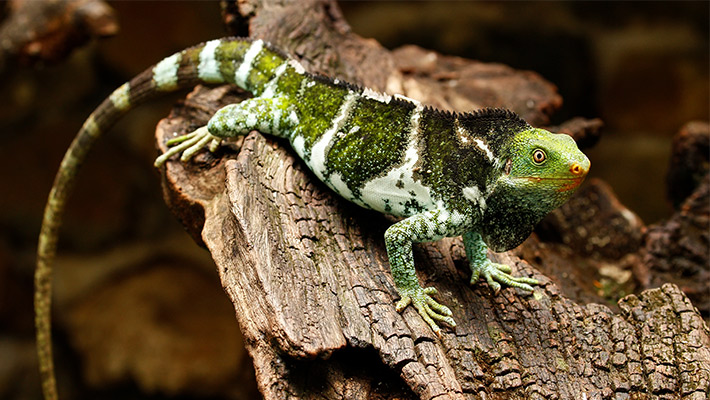Learn about the Fijian Crested Iguana
Scientific name: Brachylophus vitiensis
Classification: Critically Endangered
Size: Head and body around 25cm, plus a 50cm tail
Distribution: Found on three Fijian islands, but primarily on Yadua Taba
Habitat: Tropical dry forests
Clutch size: 2-4 eggs
Incubation: 256 days
Primary Threats: Habitat loss, invasive predators, weeds, climate change
What do Fijian Crested Iguanas eat?
Entirely herbivorous, these lizards primarily feed on leaves, fruits, and flowers from trees and shrubs. Their diets vary with seasonal availability.
An Unlikely Discovery
This rare reptile only recently became known to scientists in part due to the 1980 film The Blue Lagoon. Filmed in remote areas of Fiji peninsula, this film included shots of the iguana which were later seen by herpetologist Dr John Gibbons, who was in Fiji studying another iguana species. He then travelled to the filming locations to formally identify and study this iguana.
Where are Fijian Crested Iguanas found?
When discovered in the 1980s, the iguana could be found on 14 of Fiji’s iguanas. In that time, however, populations levels have declined by around 80%, with the iguanas now found on just three small Fijian Islands living in tropical dry forest habitat. Of these islands, they are most common on Yadua Taba, a small volcanic island. This island has now been designated as a Wildlife Sanctuary to save the species.
Saving the Species
For more than 20 years, Taronga has worked to save the Fijian Crested Iguana.
Former Taronga Ecologist Dr Peter Harlow wrote the IUCN recovery program to guide conservation efforts. Taronga’s support for the species’ survival has included developing a pest eradication program on its native Monuriki Island, devising the re-introduction program for iguanas bred in care in Fiji, and scientific monitoring to assess reintroduction survival rates.
Taronga works with other Zoos in Australia as part of a Population Management Program for Fijian Crested Iguanas, which could allow for reintroductionwild should a catastrophic event occur to the wild population in Fiji.
